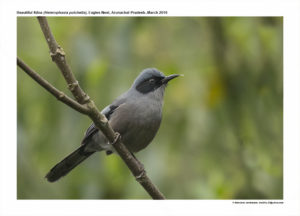Beautiful Sibia

Beautiful Sibia Heterophasia pulchella
Etymology:
- Heterophasia : Greek word heteros- different; phasis-
- Pulchella : Latin word for “very beautiful” derived from pulcher –beautiful
Vernacular Names :Lepcha: pho
Distribution inIndia:Resident in Eastern Himalayas and North East of India
Description: Size of 22-23 cm.Blue-grey babbler with black face and wing-coverts, dull brown tertials, broad black subterminal tail band. Both the sexes are similar.
Habitat: Found in moist broadleaf evergreen forest at 5000 feet–9000 feet, locally down to 1000 feet in winters.
Food Habits:They eat Insects and their larvae, including beetles; also eat seeds, including those of viburnums and evergreen magnolias.
Breeding Habits: They breed in Apr–Jul. Nest a cup made of moss, lined with rootlets, placed near end of horizontal branch of small tree.The usual clutch is about three to fiveeggs. Female incubates the eggs and the chicks are born Precocial(withopen eyes and down feathers). Both parents do the duty of feeding the chicks. The chicks fledge within 3 weeks and leave the nest post fledging within 21 days.